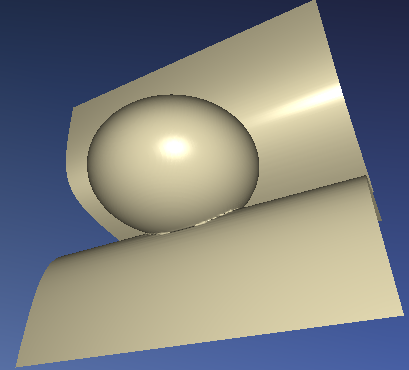Loading...
Searching...
No Matches
topology/trackImplicitPolynomialSurfaceToOFF.cpp
Implicit polynomial surface defined on the command-line by the user (as "(x^2+y^2+2z^2-1)*(z^2x-0.1)"), then extracted using digital surface tracking and converted into the corresponding combinatorial surface.
* $ ./examples/topology/trackImplicitPolynomialSurfaceToOFF "(x^2+y^2+2*z^2-1)*(z^2x-0.1)" -2 -2 -2 2 2 2 0.02 * # Digital surface has 112826 surfels. * # output in marching-cube.off (in 1809ms) * # You may display it with your favorite OFF displayer (like geomview, etc). * $ ctmviewer marching-cube.off *

Implicit polynomial surface (x^2+y^2+2*z^2-1)*(z^2x-0.1) between [-2,-2,-2] and [2,2,2], step 0.02.
#include <iostream>
#include "DGtal/helpers/StdDefs.h"
#include "DGtal/topology/helpers/Surfaces.h"
#include "DGtal/topology/DigitalSurface.h"
#include "DGtal/topology/SetOfSurfels.h"
#include "DGtal/math/MPolynomial.h"
#include "DGtal/shapes/GaussDigitizer.h"
#include "DGtal/shapes/implicit/ImplicitPolynomial3Shape.h"
#include "DGtal/shapes/implicit/ImplicitFunctionDiff1LinearCellEmbedder.h"
#include "DGtal/io/readers/MPolynomialReader.h"
using namespace std;
using namespace DGtal;
using namespace Z3i;
{
std::cerr << "Usage: " << argv[ 0 ] << " <Polynomial> <Px> <Py> <Pz> <Qx> <Qy> <Qz> <step>" << std::endl;
std::cerr << "\t - displays the boundary of a shape defined implicitly by a 3-polynomial <Polynomial>." << std::endl;
std::cerr << "\t - P and Q defines the bounding box." << std::endl;
std::cerr << "\t - step is the grid step." << std::endl;
std::cerr << "\t - You may try x^3y+xz^3+y^3z+z^3+5z or (y^2+z^2-1)^2 +(x^2+y^2-1)^3 " << std::endl;
std::cerr << "\t - See http://www.freigeist.cc/gallery.html" << std::endl;
}
{
if ( argc < 9 )
{
usage( argc, argv );
return 1;
}
double p1[ 3 ];
double p2[ 3 ];
for ( unsigned int i = 0; i < 3; ++i )
{
p1[ i ] = atof( argv[ 2+i ] );
p2[ i ] = atof( argv[ 5+i ] );
}
double step = atof( argv[ 8 ] );
// See http://www.freigeist.cc/gallery.html
Polynomial3 P;
Polynomial3Reader reader;
std::string poly_str = argv[ 1 ];
std::string::const_iterator iter
= reader.read( P, poly_str.begin(), poly_str.end() );
if ( iter != poly_str.end() )
{
std::cerr << "ERROR: I read only <"
<< poly_str.substr( 0, iter - poly_str.begin() )
<< ">, and I built P=" << P << std::endl;
return 1;
}
// Durchblick x3y+xz3+y3z+z3+5z = 0
// MPolynomial<3, double> P = mmonomial<double>( 3, 1, 0 )
// + mmonomial<double>( 1, 0, 3 )
// + mmonomial<double>( 0, 3, 1 )
// + mmonomial<double>( 0, 0, 3 )
// + 5 * mmonomial<double>( 0, 0, 1 );
// Crixxi (y2+z2-1)2 +(x2+y2-1)3 = 0
// developed = y4 +2y2z2+z4-2z2 -y2 + x6+3x4y2+3x2y4+y6-3x4-6x2y2-3y4+3x2
// MPolynomial<3, double> P = mmonomial<double>(0,4,0)
// + 2 * mmonomial<double>(0,2,2)
// + mmonomial<double>(0,2,0)
// + mmonomial<double>(0,0,4)
// - 2 * mmonomial<double>(0,0,2)
// + mmonomial<double>(6,0,0)
// + 3 * mmonomial<double>(4,2,0)
// + 3 * mmonomial<double>(2,4,0)
// + mmonomial<double>(0,6,0)
// - 3 * mmonomial<double>(4,0,0)
// - 6 * mmonomial<double>(2,2,0)
// - 3 * mmonomial<double>(0,4,0)
// + 3 * mmonomial<double>(2,0,0);
ImplicitShape ishape( P );
DigitalShape dshape;
dshape.attach( ishape );
// Construct the Khalimsky space from the image domain
// NB: it is \b necessary to work with a \b closed cellular space
// since umbrellas use separators and pivots, which must exist for
// arbitrary surfels.
);
if (!space_ok)
{
return 2;
}
MySurfelAdjacency surfAdj( true ); // interior in all directions.
// The surfels are tracked from an initial surfel, which is found by
// try/error.
MySetOfSurfels theSetOfSurfels( K, surfAdj );
Surfaces<KSpace>::trackBoundary( theSetOfSurfels.surfelSet(),
K, surfAdj,
dshape, bel );
MyDigitalSurface digSurf( theSetOfSurfels );
<< std::endl;
// The cell embedder is used to place vertices closer to the set
// P(x,y,z)=0
typedef
CellEmbedder;
CellEmbedder cellEmbedder;
ofstream out( "marching-cube.off" );
if ( out.good() )
digSurf.exportEmbeddedSurfaceAs3DOFF( out, cellEmbedder );
out.close();
ofstream out2( "marching-cube.noff" );
if ( out2.good() )
digSurf.exportEmbeddedSurfaceAs3DNOFF( out2, cellEmbedder );
out2.close();
return 0;
}
Aim: Represents a set of n-1-cells in a nD space, together with adjacency relation between these cell...
Definition DigitalSurface.h:140
Aim: A class for computing the Gauss digitization of some Euclidean shape, i.e. its intersection with...
Definition GaussDigitizer.h:80
Aim: a cellular embedder for implicit functions, (default constructible, copy constructible,...
Definition ImplicitFunctionDiff1LinearCellEmbedder.h:80
void init(ConstAlias< KSpace > K, ConstAlias< ImplicitFunctionDiff1 > f, ConstAlias< Embedder > e)
Aim: model of CEuclideanOrientedShape concepts to create a shape from a polynomial.
Definition ImplicitPolynomial3Shape.h:68
Aim: This class converts a string polynomial expression in a multivariate polynomial.
Definition MPolynomialReader.h:259
Aim: Represents a multivariate polynomial, i.e. an element of , where K is some ring or field.
Definition MPolynomial.h:970
Aim: A model of CDigitalSurfaceContainer which defines the digital surface as connected surfels....
Definition SetOfSurfels.h:74
Aim: A utility class for constructing surfaces (i.e. set of (n-1)-cells).
Definition Surfaces.h:79
Aim: Represent adjacencies between surfel elements, telling if it follows an interior to exterior ord...
Definition SurfelAdjacency.h:66
void beginBlock(const std::string &keyword="")
std::ostream & error()
std::ostream & info()
double endBlock()
DigitalSurface< MyDigitalSurfaceContainer > MyDigitalSurface
Definition greedy-plane-segmentation-ex2.cpp:89
DGtal is the top-level namespace which contains all DGtal functions and types.
Definition ClosedIntegerHalfPlane.h:49
Trace trace
STL namespace.